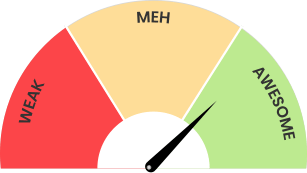
If you’re a business owner, no matter your capacity for creativity or your level of marketing expertise, you likely have never learned how to name a company using a formal process. That’s okay. It’s not something that’s taught in school unless you’ve seen me lecture at the Stanford Grad School.
Entrepreneurs often struggle to come up with business names. Sometimes they hit the nail on the head with a brilliant new business name idea. But more often than not, due to lack of training, most people end up with weak or problematic business name that they later regret when it proves troublesome. Since you’re here, that shouldn’t happen to you.
If you want to create a name for a company on your own (as opposed to hiring me or a naming firm such as Eat My Words to do it for you), naming your company is not something you can afford to be mediocre at.
Lucky for you, there are people like me who name businesses and products for a living, and even luckier for you, I want to share the wisdom I’ve acquired from doing this for more than 15 years so that you can come up with a magnetic and memorable name for your business all on your own—and not suck at it.
Why Your Company Name is So Important
The eyes are the window to the soul. And your business name is the window to your unique business identity.
This peek into your company’s persona can either effectively shine a light on the distinctiveness and merit of your business, or it can turn off prospective customers and drive them to your competitors.
Aside from benefiting from first impressions, you and your customers will have to look at, spell, and say your business name for the length of its lifespan—think of the impact that will make on your day-to-day duties and overall business plan.
Putting in the work to develop a strong and sticky business name will sow the seeds for success to bloom for years down the road. Or it will limit your growth from the get-go.
Because while you can update the layout of your website, modify your business structure, revamp your marketing strategy, evolve your value proposition, or change your business location—unless you want to invest in the cost of changing it, you’re stuck with your business name from the moment you sign off on it. That’s why you want to make sure you love it and that your customers will, too.
Why Coming up With a Business Name Can Be So Hard
A distinct and dynamic name will not only be an instrumental part of your marketing approach and a magnet for more customers; it can be the determining factor when potential customers are making a quick decision between you or your competitors.
This is quite a bit of pressure to put on you, especially if you are like most people who don’t have the time, resources, and creativity—let alone the insider naming expertise—to come up with stellar business name ideas.
Whether you are part of a large organization trying to agree on a catchy business name or are a one-person team trying to name a small business, everyone struggles with effectively naming their businesses. But it doesn’t have to be difficult. In fact, it can be fun.
How Do I Come Up With a Name for My Business?
There is a definitely a right and wrong way to go about the naming process.
The wrong way is to start by checking the domain availability. Do that last. First, concentrate on coming up with a great brand name. You can always add a modifier word during the domain registration process.
The right way to come up with the perfect business name is to first learn what makes a name strong and what mistakes to avoid. You’ll then want to complete a Creative Brief, which is a roadmap to guide your creative process. After that, you’ll be ready to start brainstorming names. I’ve provided information on all of this below.
Coming up with great business name ideas is not a science. Naming brands is an art. It’s not about linguistic voodoo, it’s about names that make emotional connections. (More on that below.)
I’m here to outline the do’s and don’ts with my tried-and-true techniques. With my straightforward brand name advice, you can have a much greater chance of landing on a strong brand name.
What Are The Rules for Naming a Company?
Before you begin to brainstorm business names, the most important thing is to know the distinct qualities of favorable business names and the unfavorable qualities of useless names.
To test the strengths and weaknesses of any name, you can run it through our free online name evaluation checklist, The Eat My Words’ SMILE and SCRATCH Test, which is based on my philosophy, “A name should make you smile instead of scratch your head.”
You want to make sure your name has all of the below qualities of SMILE and zero hazards of SCRATCH so you end up with a name that’s awesome as opposed to weak.

SMILE – The 5 Qualities That Make a Name Great
SMILE is a 5-point checklist that will help you aim for a name that has star-power. Tip: catchy business name ideas almost always make people SMILE. We appreciate it when names surprise us, entertain us, and give us a happy little jolt of dopamine. Names that make us smile are infectious. They are the ones we talk about, tweet, and repeat. Why? We enjoy making others smile too.
Suggestive —evokes something about your brand
A name can’t be expected to say everything, but it can suggest something about your brand. Not in an overly obvious way but in a way that activates the imagination. Think about what you want your target audience to know about your business or to feel when saying your company name. The name can’t tell the whole story, but it should provide a hint. Metaphorical names are great for this. Think about these SUV names: “Yukon,” “Expedition,” “Wrangler”. With just one word, they each suggest rugged adventure.
Memorable —makes an association with the familiar
According to the latest research in cognitive psychology, we remember things that can easily be merged into our existing knowledge base. One of the basic mechanisms of memory is association. The stickiest names are associated with words and concepts that are already familiar to us. Consider the educational toy company LeapFrog. Most of us played the childhood game of leapfrog. Because we have a connection to it, the name LeapFrog is easy to remember.
At the end of the day, your name is only useful if your customers can remember it to look it up online, recommend it to others, and keep coming back.
Imagery —aids memory through evocative visuals
Continue to make those memory connections by using evocative imagery within your company name. When we can visualize something more vividly, it makes a more lasting impression.
What do the names “Splash Mountain,” “Lionsgate,” and “Timberland” have in common? They all create an image in your mind that effectively portrays and promotes the products and services that are being sold.
Legs —lends itself to a theme for extended mileage
You want a name that has legs; in other words, you want a name that can be extended many different ways for your business.
You should be able to easily play with it and mold it into catchphrases, themes, and other verbal branding opportunities.
Here at Eat My Words, we’ve let the legs of our name run wild with the food theme. For instance, our blog is called the Kitchen Sink; our company email is hungry@eatmywords; and we have full-service naming packages with names like Supermarket Special and The Whole Enchilada.
Even my online course has legs. Go to the pricing section towards the bottom to see what I’m referring to.
Think of different themes that go along with your brand identity and let your imagination go with it.
Emotional—moves people
Emotion is what drives the purchasing behaviors. Not only do we buy things that make us feel good, but we are also inclined to buy things with names that make us feel good. Humans are driven by feelings. So, if you want the consumer to remember your product or brand, they must be engaged. Double down on this fact and choose a name that tugs at emotions that are aligned with your brand persona. Evoking the emotions with your company and product name is sometimes the defining factor when a potential customer picks a product.
Something as simple as changing a menu item named Chicken Soup, to the more emotion-evoking Grandma’s Chicken Soup will boost sales.
SCRATCH – The 7 Deadly Deal Breakers
When you’re starting out with a blank slate, don’t weaken your name with any disadvantages. Cr8tiv spellings, unintelligible words, and unfamiliar expressions may make you unique, but more often than not these names can spell trouble.
If you need to help someone spell, pronounce, or understand your name, you are essentially apologizing for it. Making excuses for your name devalues your brand.
Here’s an easy way to remember the next acronym, SCRATCH: If it makes you scratch your head, scratch it off the list.
Spelling Challenged —looks like a typo
If you have to spell out your company name to help customers understand, it devalues your brand and becomes a handicap to your company’s growth. Basically, if it looks like a typo, is misspelled, or has numbers in it, it will probably cause problems for years to come by deterring people from finding your company online to not knowing how to say it when recommending it.
Copycat —resembles competitors’ names
A good way to come off as an uninspired copycat is by copying another company’s name or a name that resembles another company’s a little bit too much. When you name your business by trying to ride someone else’s success, it comes off as lazy and can prevent you from creating a client base with integrity and trust. Not to mention the confusion it might cause your target market and possible trademark infringement and legal action.
Restrictive —limits future growth
Like I mentioned earlier, a magnetic name has the ability to pave the way for your company’s growth. Part of a business’s mission is to always plan for growth which is why restrictive company names are counterproductive. If your company name puts you in a strict category, it will be difficult to expand with a restrictive name. If your company sells pens and is located in Dallas, Texas, naming your company “Dallas Pen Company” will definitely limit or jeopardize your ability to expand your products and services outside of pens and Dallas.
Annoying —seems forced, frustrates customers
What is annoying of course is subjective. But if you think about your name from a customer’s point of view, you can avoid causing frustration if your name does not appear forced, abstract, or grammatically incorrect.
Cringey and nonsensical names are frustrating to customers. This includes using overused suffixes like mania, topia, vana, ology (you get the idea), as well as mixing random words to try to sound witty. It will sound as annoying to your customers as it does to you.
Tame —feels flat, descriptive, uninspired
In this social media, tech-driven world, the average American is exposed to up to 10,000 ads per day. With a flat and uninspired name, you will fade into the background of the millions of ads whirling around the internet. A million-dollar marketing budget definitely helps you stand out, but if you don’t have this kind of money, a vibrant and memorable name is the cheapest way to stand out.
Curse of Knowledge —speaks only to insiders
Nobody likes an inside joke they don’t understand. Make sure your name doesn’t only speak to insiders who can understand a distinct reference. When a customer doesn’t easily understand a business or product name, it is more likely to turn them away.
Hard to Pronounce —confuses and distances customers
Just like the Curse of Knowledge, when a customer doesn’t know how to pronounce your brand name because it’s either written in another language, spelled peculiarly, or is difficult to pronounce, it will only distance them from your business.
Apart from being frustrating to customers, a name that is difficult to pronounce will cause problems. Many companies with difficult names spend much of their marketing plan teaching the public to say their name correctly.

Become Your Own Business Name Generator
Now that you know the naming rules and the qualities that make or break a superior company name, you can start brainstorming. These are some techniques that I have used for years to come up with super sticky brand names.
Follow these steps, and you’ll have a streamlined process to name businesses, products, and services.
Complete a Creative Brief
To help you create a path for your brainstorming, it’s imperative that you have a roadmap to keep you on strategy. It’s what’s known as a Creative Brief. Here are some typical questions:
1. What do you want your business name to accomplish?
Determine what you want your brand name to communicate.
2. How do you want your brand to be positioned in the marketplace?
Detail how your business idea is different than the rest in the market and what makes it unique.
3. Who are the customers you want to reach?
Determine your primary and secondary target customers.
4. Who are your competitors?
Make a list of them so you can see who you are competing against to help you stand out and be unique.
5. How do you want people to feel when they see or hear your company name?
What emotions do you want them to experience?
6. List 5 to 10 adjectives that best describe the spirit and personality of your brand.
(If your brand was a person, how would you describe them?)
7. What are the themes, words, and ideas that you want to explore?
This will give you a jumping off point.
You can get the exact Brief we use at Eat My Words in my creativity book, as well as my popular masterclass.
Brainstorming Business Name Ideas
What is the ideal number of participants you need for brainstorming names? You may be surprised. It’s just one. You. What is the optimal place to brainstorm? Not in a sterile conference room. Instead, you should be in front of your computer. (Note: a laptop or desktop computer is much more efficient than using your phone because you will be utilizing word websites and looking at large volumes of words.)
The single most powerful brainstorming tool is the internet. Online you will find everything you need to come up with awesome and unique business name ideas.
When you brainstorm online, you’ll find yourself clicking on unexpected links and going down all kinds of rabbit holes. You never know where your next idea will come from.
Here are a few ways I go about brainstorming brand names for my clients.
Warm-Up Exercise
Begin by writing down at least 12 words that are associated with your business. For instance, if you are naming a river rafting company, you might right down, “paddle,” “oar,” “rapid,” “water,” “splash.” These are not meant to be names… they are starter words and concepts that will lead to names.
Don’t skip this step, as it will help you loosen up those brainstorming muscles and get you started.
Word Search
An online thesaurus is a motherlode when looking for word associations. It should be the first place you start in your brainstorming process. When looking for inspiration and ideas, just type in a word that may be in your Creative Brief. Skim the synonyms for interesting words that catch your eye or that more adequately describe what you’re looking for and pick a few to explore further.
An online dictionary can also be quite helpful. A dictionary doesn’t only list definitions; each word has a few hundred results, including phrases, idioms, synonyms, and more.
A Picture Says a Thousand Words
Looking at images is another great way to continue to inspire and lead you closer to the jackpot.
Professionally compiled stock photo websites such as Shutterstock.com are fantastic places to see conceptual ideas related to your name. For instance, if you are naming something “fast,” type that word into the search bar and see the visual results. You may see a runner, a race car, a rocket, a rabbit, and a roller coaster. And those are just things that start with “R.”
Culture References
Most references from pop culture are familiar and emotional to most of us, making them a great way to find inspiration for brand names.
Do a Google search of books, movies, and music that are associated with your chosen words and see what you’re drawn to or what inspires other ideas to pop up and investigate.
Business Name Generators
At Eat My Words we are naturally creative and don’t rely on business name generators, however they do exist and may be worth exploring, especially if you want a particular word in your name, for instance “Sun.” If you’re prepared to sift through pages and pages of entries, the free business name generator I recommend is BusinessNameGenerator.com. One that I do use when trying to come up with domain name modifiers is called NameStudio. Be sure to use the Brainstorming function, which may also help you with to creative name suggestions. (It’s how I came up with the names Puppy Butler and Kitten Wrangler, which were also available as domain names.)
You will arrive at the perfect name through a combination of these tactics as one search will lead to the next and then back again. The trick is to follow your curiosity and keep digging until you feel it’s a hit. Once you’ve got that hit, run it through The SMILE and SCRATCH Test to make sure you’ve got a true winner on your hands. And of course have an attorney do a trademark search to make sure your name is available. You can learn more about trademarks and do a free online search at the US Patent Trademark Office, USPTO.gov. Keep in mind this is a government agency, so the site can be a little clunky to use.

Bottom Line
It’s difficult to fit almost two decades of naming expertise into one article. That’s why I suggest you learn more by reading my book or enrolling in my insightful masterclass. Even if you don’t feel like reading my book or taking a full course, you can enjoy an hour of pure brand-name knowledge by signing up for my free mini masterclass. This colorful course is a great way to visualize a lot of the concepts and ideas I mentioned in this article. I promise you’ll be entertained and enlightened. And all of these resources provide plenty of how to name a product and how to name a company examples.

